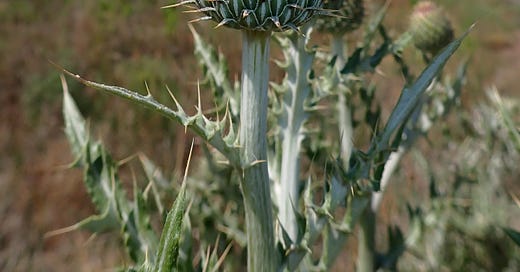Cultural Underpinnings of the “Invasive Plant” Narrative
Articles of faith that serve as a lens for our perceptions
This is a draft piece from the book-in-progress that Nikki Hill and I are working on, “Don’t Blame the Messengers: A critique of the ‘invasive plant’ narrative.” It is a short piece intended as the introduction for a section of the book. Attentive readers will note that it based on an excerpt from the previously posted essay, “To My Fellow Foragers: Non-Native Plants Also Deserve Our Respect.” When I wrote this part of that essay, I suspected I would be pulling it out and reworking for this purpose.
The acceptance of the “invasive plant” narrative in the US can be described as “reflexive.” That is, there’s nothing unconventional about it that requires thought. It makes immediate sense on a subconscious level because its defining characteristics are derived from beliefs and prejudices that are fundamental to the culture. Four major contributors are:
Xenophobia, the irrational fear of “the other”
Competition as the driving force in life
The agricultural mindset
Nature as stable and unchanging
We will detail these in following chapters., but to summarize:
Xenophobia: This ugly Western trait goes back at least as far as the Crusades and is entrenched in the United States, as seen by its long history of demonizing alleged enemies, both inside and outside its borders. Is it coincidence that the increasingly venomous rhetoric about "invasive species" over the last couple decades has tracked with intensifying anti-immigrant vitriol and the so-called “War on Terror”?
Competition: Natural interactions and “survival of the fittest” are seen through the lens of our own social structure, which is a heartless capitalism based on winners and losers. Elements like cooperation and mutualism as forces in inter-species relationships and in evolution are ignored, often because they aren’t looked for.
The agricultural mindset: Plants are classified as good (crops) and bad (weeds). While this distinction can have a purely utilitarian place in a field or a garden plot with a small cast of characters and the vital goal of growing food, it is sorely lacking as a way of comprehending inter-plant interactions in an undomesticated landscape. A farm field or backyard raised bed where weeds can overcome vegetable seedlings is not a model for understanding the interplay between native and introduced plants everywhere else.
Nature as stable: The idea of “an unchanging, orderly world”* where every living thing has a proper, appointed place is a Bronze Age relic handed down to us through Abrahamic religion. Observation and science have since revealed that life on the planet is always in flux with drifting continents, cyclical ice ages and the ever-shifting ranges of individual species. The “natural” state of nature is one of ceaseless transformation and constant adaptation. But the myth is tenacious and, more often than not, any contemporary change in an ecosystem is perceived as a negative thing by scientists and laypeople alike. Tangled up in this is the the Eden story, which sees the world as “fallen” from a previous state of perfection (which, tellingly, was a garden).
All four are essentially unacknowledged articles of faith. Rather than being understood as one set of perspectives about reality among many other possible perspectives (including those held by other cultures historically and currently), they are treated as defining and inherent facts of life.
Scientists and the pursuit of science are not free of them, and invasion biology is a prime example—perhaps the foremost—as betrayed by the insistence so far on keeping the word “invasive” itself, despite its undeniably charged connotations. (Though, as with all else, there is not consensus on this subject in the field.)
These beliefs and prejudices are the fuel that powers the “invasive plant” narrative as a cultural phenomena. As in politics, it’s all about emotion, not facts. It’s not actually about plants at all. It’s about a way of looking at the world that is chauvinistic, callous, domineering and deeply conservative, even fascist. Which describes the worst aspects of US society to a T.
Some sincere introspection, both individual and collective, could help us to see past these cultural influences, and to perceive the greater-than-human world more as it is and less as we judge it to be. Such an effort has the potential not only to educate us but also to liberate us. We hope our efforts contribute to that pursuit.





